There are literally tons of task trackers out there. Your team is small, so you have to move fast and don’t have time to figure out what’s best out there. That’s fine. Here is a list of top task trackers based on reviews, active users count and feature set, handed on a platter. Pick the one which better fits your needs — and enjoy your meal.
Asana

Asana has a unique story behind it. Founded by Dustin Moskovitz and Justin Rosenstein in 2008, it’s still widely used among many organizations. Asana emphasizes communication over task tracking, which is very well suited for elite teams of highly skilled workers — as they need less management and more leadership.
The Stand-Out
Asana kills email. Some companies reported that since moving to Asana, they have totally eliminated communication over internal mail, which is as old as Internet itself.
When Should I Use It?
Use Asana when your team consists of very productive individuals.
Pricing
$50 / mo for teams of 1-15 members. As team size grows, pricing escalates: 3x increase in team size results in 6x increase in price.
Pintask
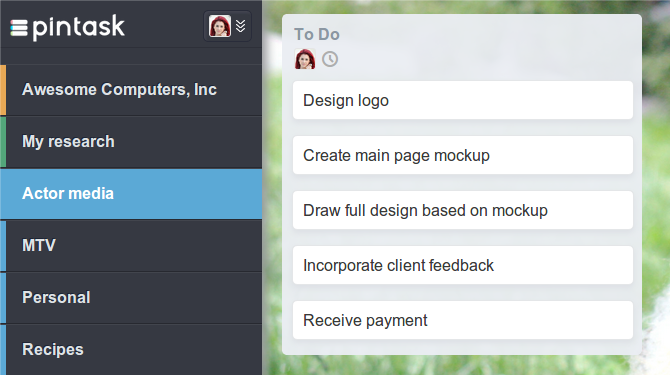
Pintask is the most customizable task tracker. You can adapt it with extensions, installed from Extensions Store or written in Javascript by yourself. It’s possible to order extensions to be written by accredited programmers, though it’s limited to Spire Club members. At its core, Pintask is a Kanban board with quick access to most useful functions.
The Stand-Out
Pintask has Extensions Store. It provides plugins and accelerators to make your work faster, and allows to write your own extensions.
When Should I Use It?
Use Pintask when you plan to automate your business.
Pricing
Pintask is free: unlimited users and project boards. It makes money off some extensions, like hands-free time tracking or mirroring of cards: $3 / mo, as of now, scheduled to rise to $10 / mo later.
Basecamp

Basecamp is the oldest app on the list. It started way back in 2004, and was redesigned in 2012. Staying in market for that long has its own advantages: it has a large user base, and there’s a lot of useful tips and best practices to be found on Internet. Basecamp is liked by even the most hardcore pen-and-paper fans.
It’s also known as a really good tool for development teams, who need a little bit more flexibility with their workflow and the way of managing multiple tasks at any given time.
The Stand-Out
Signal vs Noise blog is what made Basecamp so popular. Practically every article is worth giving a read.
When Should I Use It?
Use Basecamp when you work a lot with non-computer-savvy people.
Pricing
$20 / mo for 10 projects. As project count increases, pricing escalates: 4x more projects require 2.5x more money.
Trello

Trello is targeted on individuals in creative fields. Artists, filmmakers and even bass guitar players favor its minimalistic interface, which nevertheless has all needed functions. It’s a Kanban board-style app with focus on simplicity.
The Stand-Out
Trello is very simple. Cards on a board is a concept easy to explain even to children; adults have no problems understanding that whatsoever.
When Should I Use It?
Use Trello when your project requires more creative thought than hard execution.
Pricing
Trello at its base is free. There’s a Business Class option for $50 / mo, and Gold account for $5 / mo.
Wunderlist
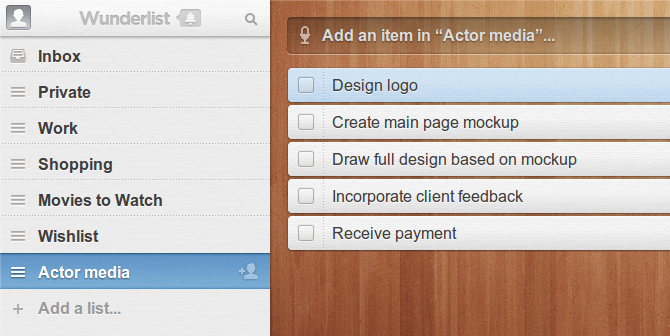
Wunderlist is renown for its snappy interface. When this app was released in 2010, it went on to be featured by Apple in their App Store. At first glance, it looks like personal to-do list, but it can be used to collaborate with team as well.
The Stand-Out
Wunderlist is eye-candy. If you need a really beautiful to-do planner, here it is.
When Should I Use It?
Use Wunderlist when your team members work mostly individually, and only coordinate general efforts.
Pricing
Wunderlist is free for personal use. However, Wunderlist Pro is required for assigning tasks to team members, and it costs $5 / mo.
Producteev
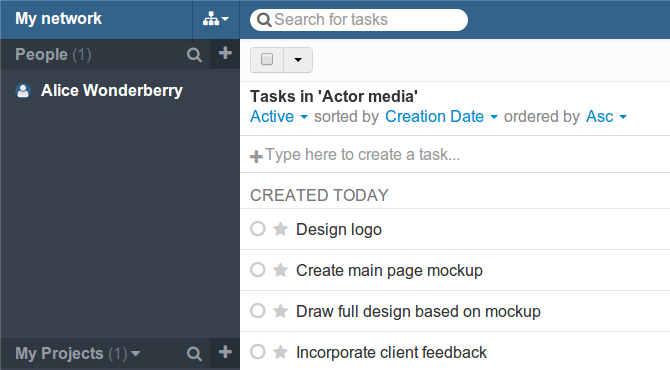
Producteev is a comprehensive set of project management tools. Now owned by Jive Software, it is a good fit for organizations small and large.
The Stand-Out
Producteev can parse properties out of task description. If you’re in a hurry, jotting down something like “Build FAQ +Danielle Cheifetz !19.04 #Marketing” will assign building FAQ to Danielle in Marketing dept on Monday.
When Should I Use It?
Use Producteev if you have a tight team of remote professionals.
Pricing
Producteev is free. However, if you want to upload your company logo, or need integration with Outlook, there’s a $99 / mo Pro plan.
Flow

Flow is all about teamwork. It helps your employees stay productive while also efficiently managing their inboxes. There’s also a dedicated feature to capture new ideas they might have during work time.
The Stand-Out
Flow puts an end to in-person meetings. Its interface is specifically designed to handle issues that arise from undocumented communication.
When Should I Use It?
Use Flow when your team members know each other well and mostly collaborate on ideas and messages.
Pricing
$19 / mo for 2 people. As team size grows, pricing escalates: 5x increase in team size leads to 4x increase in price.
Todoist

Todoist is the simplest app on this list. Despite being on market for a long time (since 2007), it has stayed a simple place for to-do items, without complex features for specialized use cases.
The Stand-Out
Todoist has a dedicated app for practically every platform imaginable, including Postbox (have you even heard about that?).
When Should I Use It?
Use Todoist when you need tight integration with existing tools.
Pricing
$999 / year. Yep, that’s right. Looks like simplicity has its price.
Podio
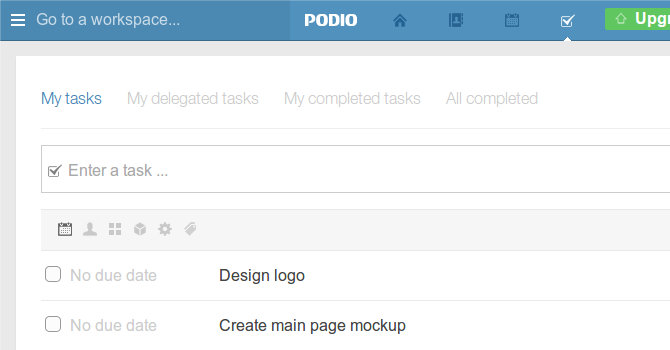
Podio is a workplace with social network elements. It also has adaptations specifically designed for various verticals, such as recruiting, sales management and general project management.
The Stand-Out
Podio has opened a physical storefront in SF for users to try out the adaptations mentioned earlier.
When Should I Use It?
Use Podio when you need an app specifically designed to fit your needs at work.
Pricing
$25 / mo for 1000 “items”, which are tasks, or projects, or any other data piece. Rather confusing, but that’s the case. As items count grows, pricing escalates linearly. There’s also an “unlimited items” plan for $500 / mo.
TeuxDeux
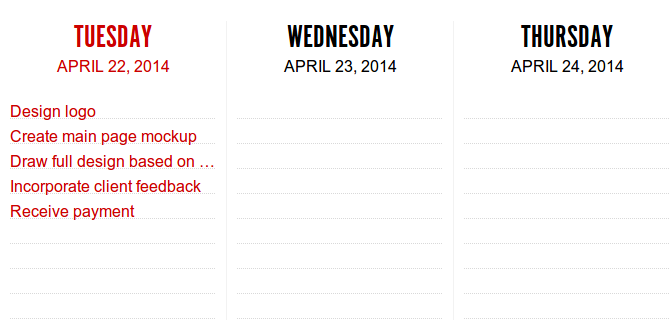
TeuxDeux is a calendar-style to-do app. It has a clean look and boasts itself as “designey”. Maybe that’s because it has been built by a design studio, as their story tells. Or maybe that’s because it’s much easier to design something really simple (which is good, not bad). Anyway, people like it for simplicity and being fun.
The Stand-Out
TeuxDeux has its voice. You always feel like you’re chatting to a friend, while using the app or browsing the docs.
When Should I Use It?
Use TeuxDeux when your to-do items are tied to week days.
Pricing
$2 / mo if paid annually, $3 / mo if paid monthly.
ProofHub
ProofHub is award-winning team collaboration and project management software that is trusted by more than 85,000 teams and organizations worldwide. Offering all powerful features in a single location, ProofHub is a must-have in any project manager’s arsenal today. Be it Task Management, Time Management, checking project’s progress with Kanban Boards, or Group Chat, ProofHub has all that will enable project managers to have ultimate control over teams and projects.
The Stand-Out
ProofHub offers fixed pricing plans, which makes it affordable for teams of all sizes to use. All tools under one roof, minimal learning curve, scalability, regular updates, and multilingual interface makes it one of the most user-friendly team collaboration and project management software available today.
When Should I Use It?
Use ProofHub when you want to have an affordable, feature-rich, all-in-one project management tool that can replace expensive multiple tools you are already using to monitor tasks and projects.
Pricing
ProofHub offers two fixed pricing plans. The Essential plan is priced at $45 per month, billed annually. More premium, Ultimate Control plan is priced at $89 per month, billed annually.
Recap
Phew, that was long enough! Now you’re well equipped to form your own judgement about which task tracker suits your team better. If still in doubt, the easiest way to choose is to sign up with a couple of services and give them a spin for a day or two — any issues will pop up during this time. And if there were none, bingo! You’ve just found a perfect tool for your needs.


Of course I’m biased, but I find the http://corbinizer.com is better than any of these services. Rocking it every day for more than 3 years
Hi Brandon,
no worries man, keep on suggesting the stuff you use, it will only help :)
Your readers will also want to consider Mavenlink, the most-installed project management software in the Google Apps Marketplace. Mavenlink has extensive task tracking tools, plus timeline management, gantt, and analytics: https://www.mavenlink.com/tour/projects
Hi Keith,
looking forward to checking it out. :)
Great list! I would like to add another tool in your list is Proofhub. Has time tracking, task management, proofing, collaboration, chat and much more. Explore more at http://www.proofhub.com/
Hey Jeff,
thanks.
Doesn’t it seem like a conflict of interest worth mentioning – maybe even worth passing up the “guest blog post” because of – that the author of this post runs one of these services?
That unmentioned association plus the laughable difference in size makes the whole post feel like a marketing piece. Thoughts?
Hey Alan,
good to hear you out. I’d love to hear you elaborate on the size difference? I’m a little buzzed right now, so I might not be following you properly, but still finding it hard to understand what you mean.
I’m fully aware of the fact that the guest author is part of the Pintask team, I actually don’t see a problem with that, considering that 9 other companies on the list are surely going to outweigh the one tiny one he has mentioned.
I am in the process of working out a set of rules and regulations (reason for removing the guest posting page completely), in order to prevent this from happening in the future. It’s a lot more work for one person than some imagine, but I’m not keen on bringing in clueless personas to fuck it all up for me.
Anyway, Alan, it seems that the community appreciated this post more than they disagreed with its content, and there seems a reasonable amount of suggestions being made as well. Looks good in that sense. I’ll pass this on to the guest author, see what he says. (and I know what he thinks…)
peace,
alex
Sounds good, Alex. Only thing I’d add is that it’s impossible to guess what the community thinks about something they didn’t know of (the the conflict of interest).
The author made two statements that are totally subjective, one of which is at best tough to justify (“top task trackers based on reviews, active users count, and feature set”) and at worst deceptive, since the post isn’t that. It’s a list of 9 task trackers with his added regardless of reviews or users.
The other statement is “the most flexible,” which again takes on a different implication because of the conflict of interest.
(It’s also possible to have a conflict of interest without even stating anything inaccurately. An alternative title could have been “9 big products which add credibility to mine.” It’s not any more or less accurate, but readers would evaluate the article differently.)
Anyway, it sounds like you have this handled. As a reader, disclosure and consistency are what matters and it sounds like you’re on the way to having both. Perhaps adding a disclaimer at the top of this article is worthwhile.
Hey Alan,
Post author here. First and foremost: thanks for feedback!
Everything Alex says is correct: I’ve indicated that I’m Pintask developer before submitting the post, and I did try to cover the competitors honestly. If I’ve missed something, please feel free to point it out — I’ll definitely listen to your opinion.
As for practice of posting aggregate reviews with own product included: it’s been openly done by trustworthy founders — http://leostartsup.com/2011/06/how-i-used-guest-blogging-for-my-startup/ — and most blogs accept such posts, because in the end it helps their readers choose from variety of options, especially when competitors outweigh by 9:1.
That said, maybe you know other ways to let community know about a new product? If so, could you please suggest them?
What about leading free team management solutions, like Bitrix24? You can’t have team task management list without B24. Redmine should be on the list as well
good suggestions, Dan. It was a guest column, so not entirely in charge of what the author had picked ;)
Thanks for this useful post.
Keep posting…..
I will! :)
Great list of task tracking apps though for most of the small and medium sized businesses, project task and time management is the most hectic task. Since better project management actually leads to overall efficiency and productivity of the business therefore it becomes of utmost importance for businesses as such.
I personally like and would recommend Replicon cloud based
project time management software which is very simple and quite hassle free application. It can be quickly implemented and can be accessed from any location using a web browser.
Being a project manager, I understand and agree how important a good and easy tool is for any business.
Hey Denny,
I had never heard of them before; looks quite good! Can you tell us a little bit more about it, and also – did you ever use any other application, perhaps any from this list? Would love to know how the transition went.
Hey Alex, Replicon’s project time management app is absolutely a great app because of many reasons, most important that it has nice calendar view interface and all reports can be easily exported to excel. Also, it can be used with QuickBooks and the best part is that it is totally hassle free and pricing is worth the results this app provided us. It is also available for some of the mobile platforms to be accessed through.
Apart from Replicon, I used Basecamp earlier and it proved to be a nice tool as well. But for our overall project and time management requirements, I found Replicon to be the best bet of course.
You can also try to look at http://www.zondertask.com it offers free trial for up to 20 users. It’s accessible online 24/7 and it lets you communicate with employees through real-time messaging and notifications
Hey buddy,
I suppose you’re one of the people behind the project. Have to say, from the first impressions it doesn’t look like a very professional site.
How long have you been working on this project and what are the future plans for it?
If you’re looking for an affordable solution, you can also check Paymo. It offers Time Tracking, project and task management, invoicing, collaboration features, mobile and desktop apps (+some more). And yes, I work for Paymo and I’m proud of it :)
This seems to be a great list.
Would like to add Invoicera to the list of products. It’s an online solution helps to manage and assign tasks to teams and keep the track of work done by your team through daily time sheets.
Todoist is not $999/year as mentioned in the post. It is $29/yr.
https://todoist.com/premium
Basecamp was my first choice after reading quite a few of these articles, it stood out the most, once we started using it I did’nt really understand why it was the go to choice. We’ve settled on Dooster, which has’nt been mentioned and are finding it alot better so far.
Hi Alex, we’ve just launched a new tool for software development teams with advanced Task Management capabilities. Would love to hear what you think of it.
SprintGround
http://www.sprintground.com
Hello, Alex. Do you mind looking at our product, https://deskun.com/ ?
We’d love to know your opinion.
Сouldn’t notice, you gentlemen argue& Might I offer a suggestion about the PM software. The thing with most task management platforms is that they are quite limited in functionalities, or if not they are very expensive (usually, speak from personal exp). At my new job we started utilizing Easy Projects, to my surprise, the best thing about it is flexible price system. We’ve customized to be a very heavy platform with many features, but it also can be quite light cloud PM SaaS.